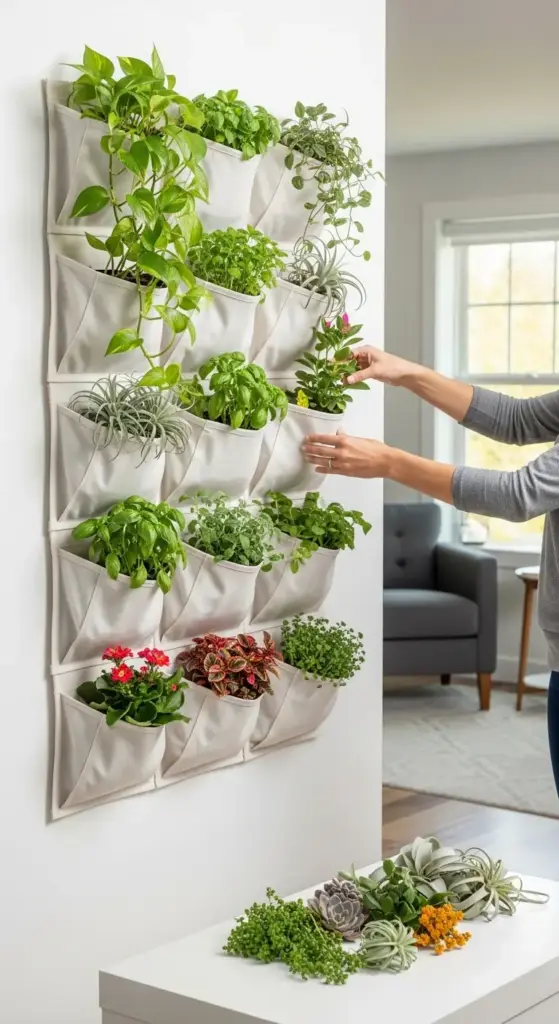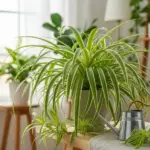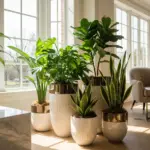5. The Modular Pocket Garden System

I used to be that person who rearranged furniture every few months because I got bored with my space. So when I discovered modular pocket gardens, it was like finding the holy grail of vertical gardening.
Finally, a plant wall I could change whenever I wanted.
My first attempt was basically fabric shoe organizers hung on the wall with random plants stuffed in the pockets. It looked exactly as bad as it sounds, and half the plants died within a month.
Building Pockets That Actually Function
The key to successful wall pocket planters is understanding that each pocket needs to work independently while looking cohesive as a whole.
I use heavy-duty canvas or vinyl with reinforced stitching. Those cheap felt organizers fall apart the moment you add wet soil.
Drainage holes are absolutely essential in each pocket. I learned this after creating a swamp situation that killed three beautiful pothos plants.
Size your pockets based on root systems – shallow pockets work for succulents and air plants, but herbs need at least 6 inches of depth.
Install grommets at the top for easy hanging and repositioning. This was a game-changer for my customizable plant walls.
Plant Rotation That Keeps Things Fresh
The beauty of modular vertical gardens is being able to swap plants seasonally without starting over completely.
I keep a “plant nursery” area where I rotate plants in and out of the wall display. It’s like having a bench of players ready to go in.
Spring rotation brings in fresh herbs and flowering plants. I love swapping winter succulents for bright green basil and cilantro.
Summer calls for trailing plants that create lush, full displays. String of hearts and pothos varieties are my go-to choices.
Fall is perfect for dramatic foliage – I bring in plants with burgundy or orange tones to match the season.
Winter rotation focuses on low-light tolerant plants and preserved elements to keep the wall interesting during darker months.
Color Coordination Without Looking Forced
Plant wall design should enhance your existing home decor, not fight with it.
I start with my room’s color palette and choose plants that either complement or provide intentional contrast. My blue living room looks amazing with orange and yellow flowering plants.
Pot coordination is just as important as plant selection. I use the same style containers throughout but vary the sizes for visual interest.
Neutral containers let plants be the stars – white, black, or natural materials work with any decor style.
Consider foliage colors, not just flowers. Silver-green succulents pair beautifully with cool-toned rooms, while deep green tropical plants warm up neutral spaces.
Space-Saving Solutions for Tiny Homes
Living in a 600-square-foot apartment taught me everything about maximizing vertical growing space without overwhelming small rooms.
Corner installations work incredibly well with modular systems. You can wrap the pockets around corners to utilize dead space.
Behind doors is prime real estate for pocket garden systems. My bathroom door has a gorgeous herb garden that nobody sees until they close the door.
Narrow hallways become green corridors with slim pocket systems. I use 4-inch wide pockets in my hallway and it completely transformed the space.
Over furniture works great too – above a desk or dresser where you can’t put anything else anyway.
Easy Maintenance and Swapping
The whole point of modular plant walls is making plant care simpler, not more complicated.
Individual watering is key. Each pocket gets watered based on its specific plant’s needs, not the whole system at once.
I keep a plant journal noting which pockets need water when. Sounds nerdy, but it prevents both overwatering and plant casualties.
Swapping plants is ridiculously easy – just lift out the old plant and drop in the new one. The whole process takes maybe 30 seconds per pocket.
Seasonal deep cleaning involves taking down the whole system, washing the pockets, and starting fresh. I do this twice a year.
Plant Combinations That Work
After two years of experimenting, I’ve found plant pairings that consistently look good and have similar care needs.
Herbs and trailing plants create beautiful functional displays. Basil at the top with trailing oregano below looks amazing and smells incredible.
Succulent combinations work well in the same pockets since they have similar water needs. I mix different textures and colors for visual interest.
Air plants with preserved moss create stunning textural displays that need minimal maintenance.
Seasonal flowering plants mixed with evergreen foliage gives you constant color with changing accents throughout the year.
Troubleshooting Common Issues
Pocket sagging happens when soil gets too heavy. Use lightweight potting mix and don’t overfill the pockets.
Uneven watering was my biggest challenge initially. Now I use a squeeze bottle to control exactly how much water each plant gets.
Plants growing too big for their pockets is actually a good problem. Just move them to larger pockets or graduate them to regular pots.
Color clashing happens when you get excited and add plants without considering the overall look. Step back and evaluate the whole wall regularly.
The indoor vertical garden trend keeps evolving, but modular systems give you the flexibility to evolve with it.
Ready to create a tropical paradise on your wall? Click below to discover how to build a dramatic fern wall backdrop that transforms any room into a lush jungle retreat – perfect for creating Instagram-worthy spaces!









GIPHY App Key not set. Please check settings